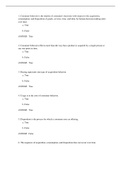1. Consumer behavior is the totality of consumers' decisions with respect to the acquisition, consumption, and disposition of goods, services, time, and ideas by human decision -making units over time. a. True b. False ANSWER: True 2. Consumer behavior reflects more than the way that a product is acquired by a single person at any one point in time. a. True b. False ANSWER: True 3. Buying represents one type of acquisition behavior. a. True b. False ANSWER: True 4. Usage is at the core of consumer behavior. a. True b. False ANSWER: True 5. Disposition is the process by which a consumer uses an offering. a. True b. False ANSWER: False 6. The sequence of acquisition, consumption, and disposition does not occur over time. a. True b. False ANSWER: False 7. The many factors that affect acquisition, usage, and disposition decisions can be classified into four broad domains: the psychological core, the process of making decisions, the consumer's culture, and consumer behavior outcomes. a. True b. False ANSWER: True 8. Before consumers can make decisions, they must have some source of knowledge or information upon which to base their decisions. a. True b. False ANSWER: True 9. Culture refers to the typical or expected behaviors, norms, and ideas that characterize a group of people. a. True b. False ANSWER: True 10. One reason marketing managers study consumer behavior is to create public awareness of inappropriate practices. a. True b. False ANSWER: False 11. Marketing managers need to understand consumer behavior to protect consumers from unfair, unsafe, or inappropriate marketing practices. a. True b. False ANSWER: False 12. Research indicates that consumers find it difficult to understand the differences between brands when they view a chart, matrix, or grid comparing brands and their attributes. a. True b. False ANSWER: False 13. A brand name is better remembered when placed in an ad that has interesting and unrelated visuals. a. True b. False ANSWER: False 14. Sellers should create the endowment effect by setting a higher price for goods than buyers are willing to pay. a. True b. False ANSWER: False 15. An offering is a product, service, activity, or idea: a. that is acquired but not used by consumers. b. that is used but not acquired by consumers. c. marketed by a firm but not yet available in the marketplace. d. made available by a marketing organization to consumers. e. that is in the marketplace but not yet accepted by consumers. ANSWER: d 16. The process by which a consumer comes to own an offering is known as _____. a. usage b. disposition c. comprehension d. acquisition e. perception ANSWER: d 17. Which of the following statements is true of acquisition behavior? a. Attitudes toward materialism, status, and self-concept do not play a role in acquisition behavior. b. Consumers tend to procrastinate in redeeming coupons and gift cards when deadlines are close. c. Ways of obtaining goods and services include renting, leasing, trading, and sharing. d. Disposition represents one type of acquisition behavior. e. Acquisition behavior of one customer cannot be linked with disposition behavior of another customer. ANSWER: c 18. Linda runs a small café. At the end of the day, she recycles all paper and plastic. In the context of consumer behavior, this is an example of _____. a. preattentive processing b. purchase behavior c. zapping d. disposition behavior




